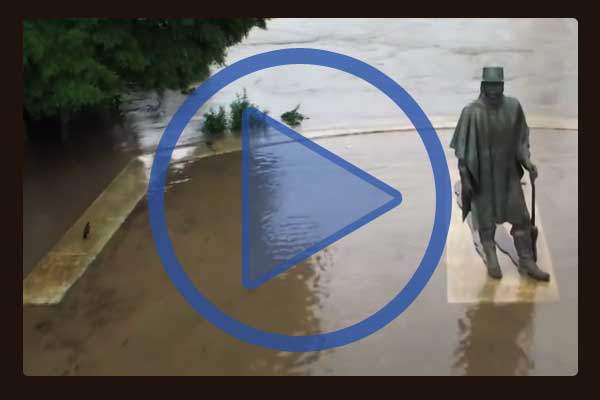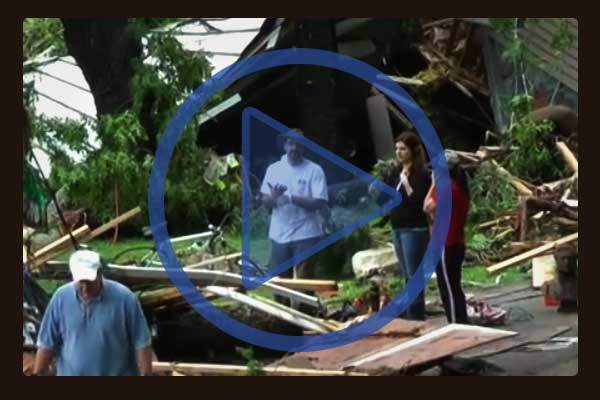In a world where we have fixated on the extreme drought in California, a deluge of rain over Memorial Day weekend has led to flash flooding and loss of life here in Texas and in Oklahoma. While our Formaspace headquarters and factory on the northeast side of Austin was not affected by flooding at all, that’s not the case further south in central Austin and in neighborhoods like Hyde Park. Portions of Austin’s Sixth Street — famous for its non-stop music venues — flooded, and a beloved old tree on “the rocks” in Zilker Park came down in the storm.

Devastation Along the Blanco River in Hays County
But the greatest damage to life and property was along the Blanco River that runs between Austin and San Antonio. The river, which on a normal day meanders through the picturesque art colony town of Wimberly, rose more than 30 feet in less than three hours (possibly as high as 47 feet). Worst of all, this flash flooding happened in the middle of the night. Entire neighborhoods of vacation rental cabins and retirement homes along the Blanco River were swept away as the waters surged. Our hearts go out to those who lost friends and family or those who are still waiting for news of missing loved ones.

Formaspace President and CEO, Jeff Turk, is actively working with Texas Search and Rescue (TEXSAR), a volunteer organization that provides search and rescue services. Jeff has been working non-stop as a volunteer helicopter pilot since the disaster, flying his own helicopter to conduct search and rescue operations. Texas Task Force One has also been deployed to search for the missing after Texas Gov. Greg Abbott declared a state of emergency. The need for assistance is great. At the end of this article will have a list of ways that you can help.

Houston, the Bayou City, is Inundated by Overflowing Bayous
The heavy weather system over Memorial Day continued to wreak havoc in Southeast Texas late Monday night and into Tuesday morning. Heavy rains poured over the Houston region, particularly Southeast Houston and its suburbs Stafford and Sugarland, which received 10 inches of rain in just a few hours. The result was massive flooding of area rivers, known locally as bayous. As the bayous filled up with rain so did many sections of the Houston freeway system, turning them into a network of flowing rivers and canals, trapping drivers in fast rising flood waters. To date three Houston area residents have died due to the flooding.
What Can be Done to Prevent this Loss of Life and Property in the Future?
Austin, and the surrounding Hill Country, has suffered from flash flooding since the early days. Austin’s first dam was built in 1895 on the Colorado River in an effort to bringing reliable electric power to city and lure industry from the East Coast. But flash flooding destroyed the original “Granite Dam” in April 1900, killing dozens and draining the new Lake McDonald reservoir. F
lood control measures along the Colorado are managed by the Lower Colorado River Authority, which was established in 1934 at the behest of the then young congressman Lyndon B. Johnson. These include the Tom Miller Dam, built in 1940 to replace the original dam that failed, and the larger Texas Highland Lakes system. The Blanco River is managed by the Guadalupe-Blanco River Authority; they have seven flood control dams along the Guadalupe River but none along the Blanco. In lieu of flood control dams, it’s certainly a good idea to keep a National Weather Service alert radio (or phone app) that will turn on in the middle the night to warn of flash floods.
Newcomers to the Austin area also need to be aware of the danger of high water on dry creek crossings. Take the posted water gauges very seriously. It only takes a foot of fast moving water to lift a car or two feet to carry away a truck or SUV. As we say “Turn Around. Don’t Drown.”
Why did the Water Rise So Quickly and Unexpectedly?
Weeks of saturating rain prior to the flood on Memorial Day weekend certainly contributed to the unprecedented flooding. In Austin, the unique geology of Hill Country contributes to the problem. The ubiquitous limestone (formed by an ancient seabed) typically found just a few feet below the ground prevents rapid water absorption from heavy rains. Steep hills and narrow valleys can concentrate the runoff, leading to flash floods. The greater Houston area, which is larger than the state of New Jersey and almost size of Massachusetts, has an entirely different flooding issue. In stark contrast to Austin, the landscape in southeast Texas is mostly coastal prairie with very little elevation change.
Water from periodic heavy rains and tropical storm deluges have to make their way east across a network of rivers (called bayous) to reach Galveston Bay before draining into the Gulf of Mexico. Houston is in the middle of a multimillion dollar flood mitigation project funded in part by a tax assessment on impermeable surfaces, like building structures and concrete parking lots. This controversial measure has helped pay for flood control measures, such as widening and restoring the area’s system of bayous. It’s not clear as to whether these partially completed measures helped reduced flooding this time or not. But Houston has to learn to deal with torrential rains.
In 2001 Tropical Storm Alison lingered over the area for 16 days, causing substantial flooding in most of the city and up to $9 billion in damage. Particularly hard hit were below-grade facilities at the Texas Medical Center. Since that time, businesses and institutions across Houston have been working hard to relocate critical systems like elevator control panels, power generation systems, etc. to higher ground. But the potential for flooding remains; the highest single rainfall total ever recorded in the United States was just south of Houston — Alvin, Texas — where a U.S. record of 43 inches of rain fell in just one day — on July 25, 1979.
When Bad Weather Strikes: How to Give Back to the Community
Your financial contributions and volunteer efforts will go a long way to help the community. Here are some suggested charities and organizations that would welcome your help. Texas Search and Rescue United Way of Houston In Hays County, call the Hays County Texas hotline at 512-754-2275 for ways to volunteer, donate or seek assistance. Finally, the University of Texas at Austin has offered its Conservation Services to flood victims who want to have paper documents or similar heirlooms restored from water damage.
Formaspace is Looking to the Future

We invite you to join the roster of satisfied Formaspace technical, manufacturing and laboratory furniture clients — including Apple Computer, Boeing, Dell, Eli Lilly, Exxon Mobile, Ford, General Electric, Intel, Lockheed Martin, Medtronic, NASA, Novartis, Stanford University, Toyota and more.
Give us a call today at 800.251.1505 to find out more about the Formaspace line of built-to-order computer workstations, industrial workbenches, laboratory furniture, lab benches and dry lab/wet labs — as well as our design / furniture consulting services. Like all Formaspace furniture, it’s backed by our famous 12 year, three shift guarantee.








